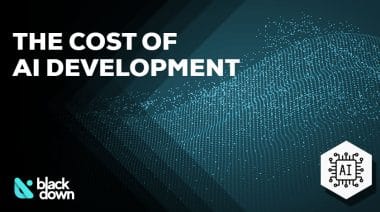Ever watched users interact with your app’s personalized recommendations? They tap and scroll like it’s magic. But as a developer, you know better – there’s nothing magical about the technical headaches behind those features.
Mobile apps with AI features are everywhere now, but building them comes with plenty of challenges. Users simply expect smart features while developers struggle with device limitations and complicated implementations.
Let’s skip the hype and get into the nuts and bolts of adding AI to your mobile apps in 2025, with code you can actually use.
On-Device vs. Cloud: Where Should Your Code Run?
First big decision: where does your AI code execute? On the user’s device or your servers? This choice affects privacy, performance, and battery life.
On-device processing keeps data on the phone and works offline, but you’re limited by hardware. Cloud processing gives you massive computing power but requires internet and adds delay. Most apps now mix both approaches.
Reality Check: Processing on-device cuts response time by 75-90% compared to cloud – critical for things like AR filters that need to feel instant.
On-Device Implementation: Maximum Privacy and Speed
kotlin// Android TensorFlow Lite implementation (Kotlin)
class ImageClassifier(private val context: Context) {
private lateinit var interpreter: Interpreter
init {
val model = FileUtil.loadMappedFile(context, "model.tflite")
val options = Interpreter.Options().apply {
setNumThreads(4) // Optimize for quad-core processors
setUseNNAPI(true) // Use Neural Network API when available
}
interpreter = Interpreter(model, options)
}
fun classify(bitmap: Bitmap): List<Recognition> {
// Preprocess and run inference
// ...
}
}Try This: Download a pre-trained TensorFlow Lite model from TensorFlow Hub and integrate it into your Android app using the code pattern above. Start with a simple image classification model to understand the implementation flow.
Cloud-Based Processing: Unlimited Power
For tasks requiring massive computational resources, cloud processing provides virtually unlimited power but introduces new challenges:
swift// iOS cloud vision implementation (Swift)
func analyzeImage(_ image: UIImage, completion: @escaping (Result<VisionResult, Error>) -> Void) {
// Compress image before upload
guard let imageData = image.jpegData(compressionQuality: 0.7) else {
completion(.failure(VisionError.imageConversionFailed))
return
}
// Configure and execute network request
// ...
}Common Mistake: Many developers fail to implement proper error handling for network connectivity issues, leading to poor user experience when the device is offline. Always build fallback mechanisms for cloud AI features.
Hybrid Approaches: The Best of Both Worlds
Most successful implementations now use hybrid approaches that balance on-device and cloud processing:
kotlinclass SmartAnalyzer(
private val localModel: ImageClassifier,
private val cloudService: CloudVisionService
) {
suspend fun analyzeImage(bitmap: Bitmap): AnalysisResult {
// First try local processing
val localResult = localModel.classify(bitmap)
// If confidence is high enough, use local result
if (localResult.confidence > 0.85) {
return createResult(localResult)
}
// Otherwise, if network available, use cloud
if (isNetworkAvailable()) {
try {
return cloudService.analyze(bitmap)
} catch (e: Exception) {
// Fall back to local result on failure
return createResult(localResult)
}
}
// No network, use local result
return createResult(localResult)
}
}Task: Build a Network-Aware AI Feature
- Implement a connectivity checker in your app
- Create a decision tree that routes processing based on:
- Network availability and speed
- Task complexity
- Battery level
- Add graceful degradation for offline scenarios
Picking the Right Tools
Your choice of AI framework affects both how efficiently you develop and how well your app performs. Here are the top contenders:
TensorFlow Lite
Google’s solution works across platforms and shines on Android:
kotlin// Model optimization in TensorFlow Lite
private fun loadOptimizedModel(context: Context): Interpreter {
val model = FileUtil.loadMappedFile(context, "model.tflite")
return Interpreter(model, Interpreter.Options().apply {
setUseNNAPI(true)
setAllowFp16PrecisionForFp32(true) // Use FP16 for better performance
setNumThreads(Runtime.getRuntime().availableProcessors())
})
}For Beginners: Start with ML Kit instead of raw TensorFlow Lite if you’re new to mobile AI. It gives you high-level APIs for common tasks with minimal code.
For Advanced Developers: Look into delegate APIs to use specialized hardware like GPUs and DSPs for up to 5x performance gains.
Check out the official TensorFlow Lite guide for documentation and examples.
Apple Core ML
Apple’s framework works seamlessly with iOS hardware:
swift// Core ML with Vision framework integration
func classifyImage(_ image: UIImage) {
guard let model = try? VNCoreMLModel(for: MyModel().model) else { return }
let request = VNCoreMLRequest(model: model) { request, error in
guard let results = request.results as? [VNClassificationObservation] else { return }
// Process top results
DispatchQueue.main.async {
self.handleClassification(results)
}
}
// Execute request
try? VNImageRequestHandler(cgImage: image.cgImage!).perform([request])
}Apple offers excellent Core ML resources and documentation for iOS developers.
Task: Optimize Model Loading
- Implement lazy loading for your AI models
- Add memory management code that releases models when not in use
- Test your implementation with Instruments (iOS) or Profiler (Android)
Architecture Patterns That Actually Work
Good architecture is crucial for building AI features that don’t break or bog down your app. Try these patterns:
Service Layer Pattern
Keep your AI functionality in dedicated services that talk to the rest of your app:
kotlin// Kotlin implementation of service layer pattern
class ObjectDetectionViewModel(private val detectionService: ObjectDetectionService) : ViewModel() {
private val _results = MutableLiveData<List<DetectionResult>>()
val results: LiveData<List<DetectionResult>> = _results
fun detectObjects(imageUri: Uri) {
viewModelScope.launch {
try {
val results = detectionService.detectObjects(imageUri)
_results.postValue(results)
} catch (e: Exception) {
// Handle errors
}
}
}
}Resource Manager Pattern
Manage your AI models efficiently to avoid memory issues:
swift// Swift implementation of resource manager pattern
class ModelManager {
static let shared = ModelManager()
private var loadedModels: [String: MLModel] = [:]
func getModel(name: String) -> MLModel? {
if let model = loadedModels[name] {
return model
}
// Load model if not cached
do {
let model = try loadModel(named: name)
loadedModels[name] = model
return model
} catch {
print("Failed to load model: \(error)")
return nil
}
}
func releaseModel(name: String) {
loadedModels.removeValue(forKey: name)
}
}Common Mistake: Not releasing AI resources is a recipe for memory leaks and crashes. Always implement proper lifecycle management for your models.
Optimization Techniques for Mobile AI
Mobile AI requires careful optimization to ensure smooth performance:
Model Quantization
Reduce model size and increase inference speed with minimal accuracy loss:
python# Python code to quantize TensorFlow Lite model (pre-deployment)
converter = tf.lite.TFLiteConverter.from_saved_model(saved_model_dir)
converter.optimizations = [tf.lite.Optimize.DEFAULT]
converter.target_spec.supported_types = [tf.float16]
tflite_quant_model = converter.convert()
# Save the quantized model
with open('model_quantized.tflite', 'wb') as f:
f.write(tflite_quant_model)Try This: Take an existing model and create quantized versions (INT8, FP16) to compare size and performance differences. Measure inference time and accuracy to find the optimal balance for your use case.
Background Processing
Prevent UI freezes by running AI operations on background threads:
kotlin// Kotlin coroutines for background AI processing
class ImageProcessor(private val classifier: ImageClassifier) {
private val scope = CoroutineScope(Dispatchers.Default + SupervisorJob())
fun processImageAsync(bitmap: Bitmap, callback: (List<Classification>) -> Unit) {
scope.launch {
val results = classifier.classify(bitmap)
withContext(Dispatchers.Main) {
callback(results)
}
}
}
fun cleanup() {
scope.cancel()
}
}For Beginners: Start with simple thread management using Kotlin Coroutines (Android) or Grand Central Dispatch (iOS).
For Advanced Developers: Implement more sophisticated threading strategies like work stealing or priority-based scheduling for complex AI workloads.
Real-World Examples
Instagram’s AR Effects
Instagram built a multi-stage processing pipeline for their face filters:
- Face detection runs entirely on-device
- Initial model runs at 60 FPS with 8-bit quantization
- Complex effects use progressive loading
- Memory system releases unused filter resources when you switch
Spotify’s Recommendation Engine
Spotify combines on-device and cloud AI for their recommendations:
- Usage patterns analyzed on-device for privacy
- Lightweight models make initial suggestions offline
- Deep neural networks in the cloud refine recommendations
- Pre-cached recommendations work offline
Creating Your Implementation Plan
Need help navigating the complexities? Working with AI development services can save you time. Going solo? Here’s a checklist:
Task: Plan Your AI Features
- Figure out which features truly need AI (hint: not all of them do)
- Ask these questions for each feature:
- Does it handle sensitive user data?
- How fast does it need to respond?
- How complex is the model?
- Pick on-device, cloud, or hybrid for each feature
- Choose your frameworks and optimization methods
- Implement good architecture patterns
- Test everything on real devices
Good mobile AI requires both technical skills and thoughtful design. Understanding the challenges and solutions lets you build AI features that actually work well for users.
Know your tools, test thoroughly, and focus on user experience. Do these things right, and you’ll build AI features that genuinely improve your app instead of just checking a marketing box.
Alexandra Chen
Related posts
Popular Articles
Best Linux Distros for Developers and Programmers as of 2025
Linux might not be the preferred operating system of most regular users, but it’s definitely the go-to choice for the majority of developers and programmers. While other operating systems can also get the job done pretty well, Linux is a more specialized OS that was…
How to Install Pip on Ubuntu Linux
If you are a fan of using Python programming language, you can make your life easier by using Python Pip. It is a package management utility that allows you to install and manage Python software packages easily. Ubuntu doesn’t come with pre-installed Pip, but here…











